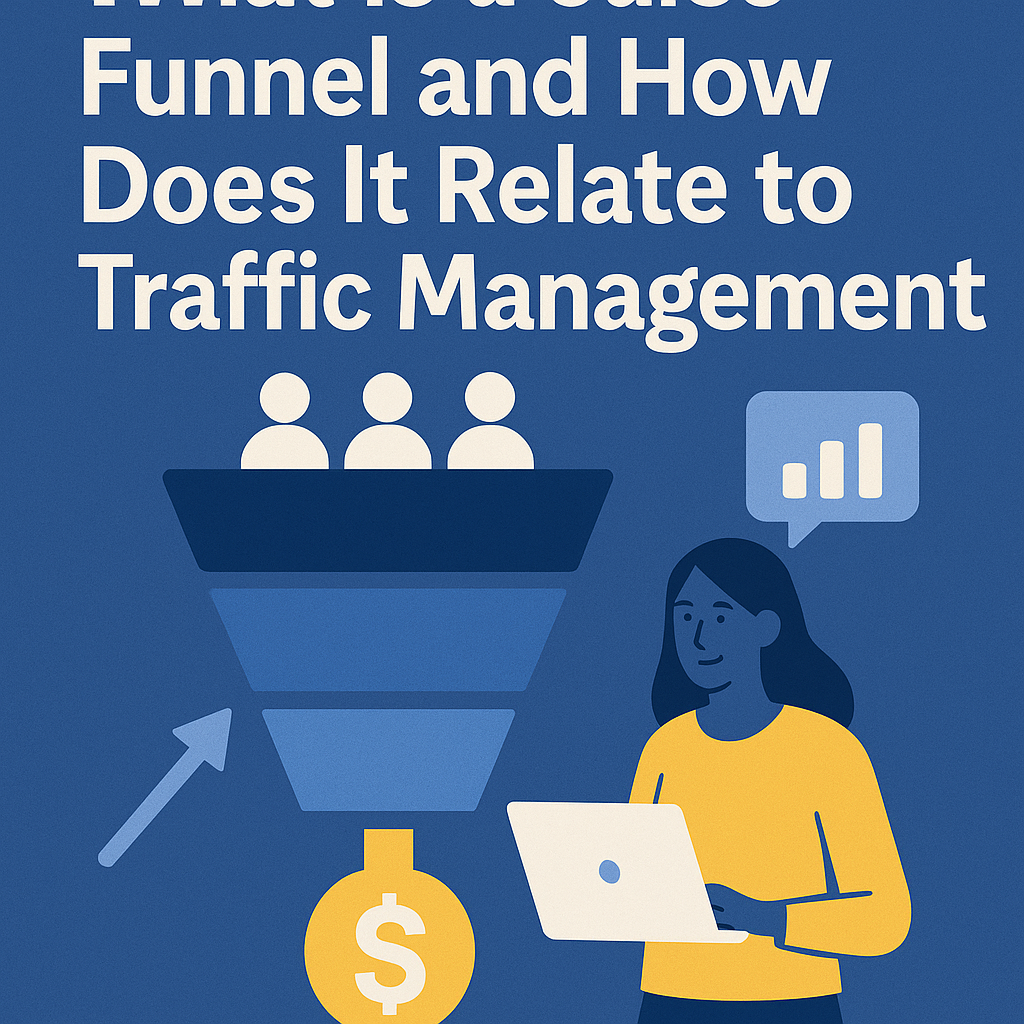If you’re learning traffic management, you’ve probably heard the term “sales funnel” more than once. But what exactly is it? And how does it affect the way you run ads and manage campaigns?
In this article, you’ll understand what a sales funnel is, why it matters in digital marketing, and how a good traffic manager works in harmony with each stage of the funnel to generate leads and sales efficiently.
What Is a Sales Funnel?
A sales funnel is a step-by-step process that guides a potential customer from the first interaction with a brand to the final purchase—and often beyond.
Imagine an actual funnel: wide at the top, narrow at the bottom. That’s how leads behave. Many people enter the funnel, but only a percentage reach the final stage and convert.
The funnel helps businesses:
- Organize marketing and sales actions
- Identify where people are dropping off
- Optimize each stage for better performance
- Guide cold audiences toward becoming buyers
The 3 Main Stages of a Sales Funnel
Most funnels are divided into three main phases:
1. Top of Funnel (TOFU) – Awareness
At this stage, people are cold. They don’t know your brand, product, or offer.
The goal is to grab attention and build trust.
Examples of TOFU content:
- Social media ads or posts
- Blog articles
- YouTube videos
- Free resources (e.g., checklists, guides)
- Short educational or entertaining videos
As a traffic manager, this is where you run reach, video views, or engagement campaigns. Your goal is not to sell—just to start the relationship.
2. Middle of Funnel (MOFU) – Consideration
Here, your audience is warm. They’ve seen your content, visited your site, or engaged with your brand.
The goal is to educate, build authority, and move them closer to a decision.
Examples of MOFU actions:
- Webinars
- Email sequences
- Product demos
- Testimonials or case studies
- Lead generation forms
As a traffic manager, this is where you use retargeting ads, lead ads, and custom audiences based on TOFU engagement. You might start promoting low-ticket offers, free trials, or consultations.
3. Bottom of Funnel (BOFU) – Decision
This is the hot audience—people who are ready to buy.
The goal here is to convert.
BOFU examples:
- Direct sales pages
- Cart checkout
- Limited-time offers
- Product comparisons
- Retargeting ads with urgency or scarcity
At this stage, your ad campaigns focus on conversions, and your messaging highlights benefits, bonuses, and trust.
Why Sales Funnels Matter for Traffic Managers
When you understand how the funnel works, you can:
- Create the right ad for the right stage
- Avoid wasting budget on cold audiences with hard-sell offers
- Build better retargeting strategies
- Track performance by funnel stage
- Collaborate better with copywriters, designers, and sales teams
A traffic manager who understands funnels brings more value than someone who just “launches ads.”
How to Build Ad Campaigns Based on the Funnel
Here’s how you might structure campaigns according to funnel stages:
| Funnel Stage | Audience Type | Campaign Objective | Example Ad |
|---|---|---|---|
| TOFU | Cold traffic | Video views, reach, engagement | “5 Tips to Grow Your Business with Instagram” |
| MOFU | Warm traffic | Lead generation, traffic | “Download Our Free Instagram Growth Guide” |
| BOFU | Hot traffic | Conversions | “Enroll Now – Only 2 Days Left to Join” |
This structure lets you guide leads from awareness to action, instead of jumping straight to a sale.
Retargeting and Funnels
Retargeting is a key tactic in moving people through the funnel.
For example:
- Someone watches 75% of your video (TOFU) → you retarget them with a free download (MOFU)
- They download it but don’t buy → you retarget with a testimonial ad (BOFU)
- They visit the checkout page but don’t buy → you show urgency or offer a bonus
Each retargeting step aligns with where the person is in the funnel. That’s how you reduce CPC, increase conversion rate, and build trust.
How to Analyze Funnel Performance
Use metrics like:
- CTR (Click-Through Rate) for TOFU engagement
- Lead cost and quality for MOFU effectiveness
- CPA (Cost per Acquisition) for BOFU results
- ROAS (Return on Ad Spend) to evaluate the whole funnel
If people are dropping off at a certain stage, analyze the content, messaging, and targeting. Sometimes the issue isn’t the ad—it’s the funnel step.
Tools to Help You Manage Funnels
- Meta Ads Manager: for building funnel-based campaigns and custom audiences
- Google Analytics 4: to track funnel steps across website visits
- ClickFunnels, LeadPages, or WordPress: to build funnel pages
- ActiveCampaign or MailerLite: for email nurturing in MOFU
- Hotjar or Microsoft Clarity: to watch where users drop off
A complete toolkit gives you more control and better insights.
Final Thoughts: Great Traffic Managers Think Like Funnel Architects
Running good ads isn’t enough. The best traffic managers understand how ads fit into the larger customer journey. A well-designed funnel, supported by smart traffic strategy, delivers consistent results and scalable growth.
So next time you launch a campaign, ask yourself:
- What stage of the funnel is this ad targeting?
- What action do I want the user to take next?
- What’s the follow-up step if they don’t convert?
When your ads and funnel are aligned, conversions flow naturally—and your clients will thank you for it.

